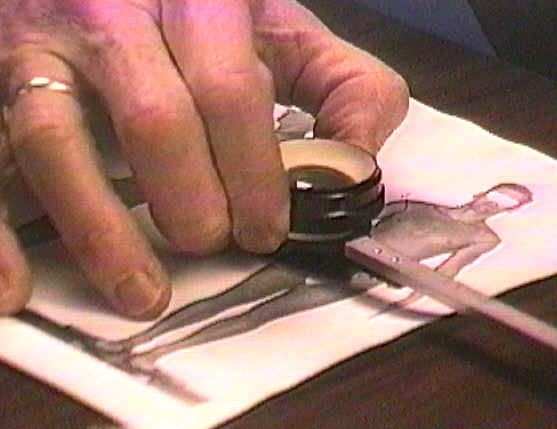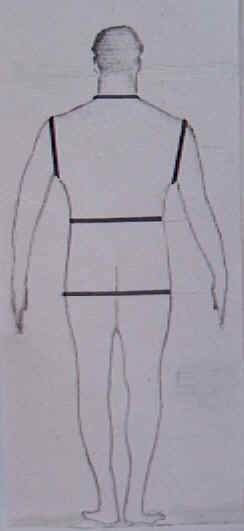

Areas to measure when determining the trunk index
Among these studies pride of place should go to Sheldon's final paper entitled, "Psychotic Patterns in Physical Constitution", a 30-year follow-up of 3,800 psychiatric patients in New York State, which was given at a symposium on schizophrenia in New York in November, 1968. Unfortunately, by then, his critics had dominated the field for so long that it must have appeared to the psychological community that Sheldon had nothing to say in his own defense, and this paper did little to change that state of affairs. His critics, if they heard about it, which was not too likely, ignored it. This is unfortunate because it is a brilliant piece of work that is very much Sheldon at his best, sharp and perceptive. It contains two sections: one, a preliminary report on the psychiatric studies that he and his colleagues had carried out over the course of 30 years in various hospitals around New York State. The other part was the final objectification of somatotyping. Sheldon reviews his previous work, and then turns to the objections brought against it, admitting that in his Varieties of Human Physique, "a number of major problems were doubtless oversimplified and some were left unexplored or even worse, unmentioned." (p. 844) He summarizes the objections under four headings: (1) the somatotype changes (2) somatotyping is not objective (3) there are only two, not three, primary components (4) somatotyping omits the factor of size.
In considering the first objection he describes his early attempts during the time of his Ph.D. thesis to identify the primary factors in physical constitution: "Thurstone decided that 4 primary factors were demonstrated and that one of these factors was size. When we expressed all the measurements as ratio to stature, thus eliminating size, three factors remained." (p. 844) These Sheldon took to be expressions of the three components he had discovered by his inspection of the somatotype photographs. If there were no relationship between the three, there should have been 343 somatotypes. If the correlations were highly negative there would not be three components, but only two, which, as we have seen, was a conclusion many of his critics arrived at. But Sheldon felt that this was not a good conclusion to come to when dealing with a three-dimensional organism. So he tried to steer a middle path. After a series of discussions with Thurstone he decided there was no way, a priori, to determine how many somatotypes there would be. It was going to be a process of "try it out and see". In his first book he identified 76 somatotypes. By 1954, in The Atlas of Men, there were 88, and the search still went on for those measurements which would more and more objectively determine the somatototype which Sheldon felt remained stubbornly constant through life. Finally, he discovered what he called the trunk index, which is the ratio of the thoracic trunk over the abdominal trunk. In other words, the trunk is divided at the waist into two sections and the area of each is measured by means of a planimeter on the standard somatotype photographs. Its discovery paved the way for solving three of the objections to somatotyping. It distinguished between endomorphy and mesomorphy; it remained constant from about the third year of life to old age, despite variations in fatness or leanness, and it opened the way for the complete objectification of somatotyping.
Sheldon had extensive opportunities to test out this new index. He examined the photographs of 400 subjects who were part of the Berkeley Growth Study, for whom somatotype photographs were taken since they were children until they were fully grown. The trunk index remained constant. He looked at the somatotype photographs taken at the University of Minnesota during a starvation experiment. Starvation had not changed the trunk index. He also examined West Pointers upon entering and leaving the Academy after closely supervised body-conditioning programs, Columbia University students who had been photographed as freshmen and then had been somatotyped 40 years later, a series of 46 identical twins, and men and women in a weight-reduction clinic, which included women who had lost as much as 150 pounds. In all these series the trunk index remained unchanged from early childhood onwards.
He finally had an objective way to distinguish between endomorphy and mesomorphy. He had a second parameter in the maximum weight the subject had reached, and he found the third in stature. This would allow him to measure the three-dimensional organism: "First we have to have a measure of massiveness; then a separator for the two kinds of mass (endomorphy and mesomorphy); finally a measure of the degree of stretched-outness into space." (p. 848) The Trunk Index has zero correlations with stature and ectomorphy. The correlations between endomorphy and mesomorphy approach zero in both sexes, and the correlations between ectomorphy and endomorphy and ectomorphy and mesomorphy average about -.40. Sheldon realized that in his earlier more visually oriented methods he had been doing the equivalent of taking into account both stature and the trunk index, but indirectly. Now he could simply measure maximum weight, height and the trunk index and calculate the somatotypes, and he could answer the objections against his somatotyping:
"1) The somatotype changes. It cannot change, since maximal stature and maximal massiveness are simply items of historical fact, and TI (Trunk Index) is constant through life.
2) Is not objective. Now it is completely objective. Can be derived on a computer as a function of three parameters, thus providing an operational definition of the procedure.
3) There are only two, not three primary components. This difficulty no longer exists. It arose from the fact that the negative correlations among the primary components were too high. That condition has been corrected, thus permitting us to live and operate in three spatial dimensions again.
4) Omits the factor of size. Size has been restored by using stature as a determining parameter." (p. 848-9)
It gives one a strange feeling to read Sheldon's culminating contribution against the background of all the criticism his work provoked, and to realize it was met with a thundering silence. Here was a completely objective method that could be replicated by anyone, but virtually no one bothered. That this would happen is a good illustration of how much the scientific process is wrapped up in human nature with its passions and weaknesses. Sheldon resists objectification, antagonizes his critics, finally comes up with an objective method, and no one seems to have the time to examine it. But its implications are enormous. If this objective method is viable, and there is no reason to think that it is not, then it sheds an interesting light on Sheldon's less objective methods and on the question of the relationship between somatotype and temperament. If Sheldon was substantially correct in his choice of the three factors, was he also correct in finding a close relationship between somatotype and temperament? Let's look at two other studies, one which makes use of Sheldon's latest method, and another which studies the relationship between physique and temperament.
Richard Walker and James Tanner in their "Prediction of Adult Sheldon Somatotype I and II from Ratings and Measurements at Childhood Ages" (1980), examined the photographs of 82 boys at ages 5, 8, 11, 14 and 18, using both Sheldon's anthroposcopic method and his objective method. They found interjudged correlations for the anthroposcopic ratings ranging from .79-.93, while the correlations for the Trunk Index method ranged from .94-.99. The mean somatotype changed little with age by either method, and the correlations between the two ratings were in the low .80s. In the case of the anthroposcopic ratings, nearly 40% of the ratings were identical, and nearly 80% within a half point. With the Trunk Index method, there was nearly complete agreement for ectomorphy, and 87-96% of the ratings for mesomorphy and endomorphy fell within a half a point.
A Reading from Tracking the Elusive Human, Vol. 2